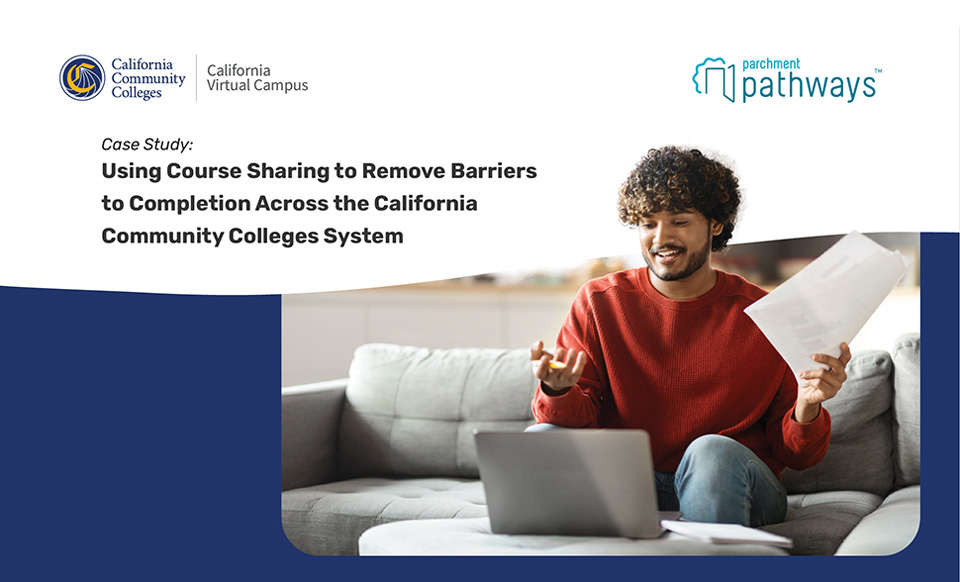
Higher Ed
The Next Five Years of Digital Credentialing: Brighter Higher Education Pathways
What do the next five years of digital credentialing look like? Learn how microcredentials, badges, and skills can shape higher education pathways.

Learn how Parchment Pathways – Course Sharing is helping the California Community Colleges leverage the power of their system to provide more opportunities for learners to complete their degrees.


According to the National Center for Education Statistics (NCES), more than a third of learners do not complete a four-year degree in six years. State systems, institutions, and consortia are exploring new ways to support learners to help them continue on the path to a valuable credential. For the California Community Colleges, one of the solutions to the problem of persistence is course sharing (also referred to as “cross enrollment”). Defined as “when two or more institutions collaborate to make their courses available to each other’s students for credit at their home institution”, the goal is to increase access and academic opportunity by giving learners more options to take courses as part of a system-wide approach.
For most learners, the experience of scheduling courses leaves a lot to be desired. A typical goal at a California community college is to earn a degree or certificate quickly or obtain the requisite credits to transfer to a four-year institution. Learners may be working full-time or have family obligations that limit their flexibility when registering for classes, and this may be particularly true for community college students. Often feeling discouraged by limited course availability and the time and money it takes to achieve their degree or accumulate credits, many students, frustrated by the experience, stop or drop out.
A course sharing initiative can resolve the challenges described above. The California Virtual Campus is a systemwide resource that unites the online course schedules of the 116 colleges in the California Community College System into a single exchange, or platform. Learners can seamlessly take classes at another institution without having to apply or matriculate. Dr. Marina Aminy, Executive Director of California Virtual Campus, explains why unifying the system is a win for learners by saying, “We are leveraging the power of our system to grow the opportunities for learners to complete their degree. The idea is that students are no longer limited to the one institution they’re enrolled in, increasing their ability to take classes and finish their goals. Learners are typically enrolled in at least one class at their home college, but now they can take classes online, unrestricted by the specific offerings at their home college. The idea of course sharing is to open up the walls of our class schedule to allow students to take classes seamlessly and easily at any of the other institutions in our system without that secondary application process blocking their way.”
“We are leveraging the power of our system to grow the opportunities for learners to complete their degrees. The idea is that students are no longer limited to the one institution they’re enrolled in, increasing their ability to take classes and finish their goals.”

Dr. Marina Aminy
Executive Director, California Virtual Campus
Getting the entirety of the system to adopt course sharing is no small task, however. One of the common misconceptions around course sharing is that it can hurt retention at the home campus. In short, campuses were concerned about losing enrollment if learners were granted the ability to take courses elsewhere. Mike Vogt, Director of Strategic Planning and Operations at California Virtual Campus, explains, “There was definitely some concern out there among enrollment managers when we first began.”
The California initiative eased these concerns by building reciprocity into their course-sharing agreements. Mike describes the solution, “We definitely leverage the concept of a true exchange. In order to be a teaching college, you have to be a home college. What enrollment managers started to realize was that for every student who took a unit somewhere else, they were getting students coming in. So there was no net loss in the system.It’s truly an exchange in the sense that both home colleges and teaching colleges benefit.”
Additionally, California incentivized degree completion in their funding model, making it critical for campuses to give learners the most productive path to graduation rather than just focusing on enrollment. Marina describes that without a proper course-sharing exchange, learners would simply take matters into their own hands and attempt to do this on their own. She describes what they found and how the data enabled them to get cooperation system-wide. “Swirling means that your students are already leaving your institution to take classes elsewhere. They are trying to cobble together their own solution. They don’t want to wait for a college to offer the one class they need every two years when another institution offers it today. However, we’re making them do it the hard way. We’re making them apply, wait for admission, wait for studentization, email addresses, and access. Initial data showed that a good portion of California community college students were already swirling and that their needs were not being adequately served through the existing process.”
The California Community Colleges are thriving in the use of their course sharing initiative. Learners are using the platform, powered by Parchment Course Sharing, to get the courses they need when they need it, and institutions are benefitting from the operational efficiency and additional enrollments. Marina shares the impact of their cross-enrollment strategy, “The data have shown how much value course sharing provides students. We’ve had over 17,000 enrollments in 2023-24, which is significant, given that we haven’t yet advertised this to students and we are still implementing many of our colleges. Over 80% of those enrollments have been single-course enrollments, which suggests that students truly are using this as a cross-enrollment tool to complete their degree or continue their pathway.”
And not only are students completing their program or getting the credits they need to transfer, California is finding that it is also giving learners a path to earn more credentials. Mike explains, “We’ve seen learners complete multiple credentials now through course sharing. They will wrap up their program at their home college, which they weren’t able to do without course sharing, and they stumble onto a micro-credential at the teaching college and say, ‘hey, you know what? I’m going to take more classes with you and keep going’. It’s truly a scenario where everyone wins.”

